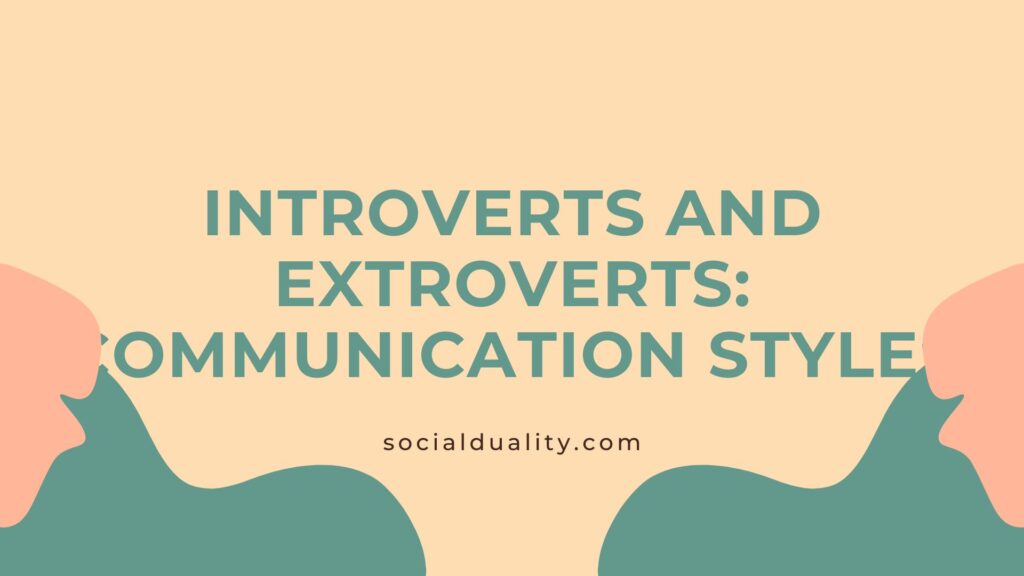Communication is a complex dance, and everyone has their own unique rhythm. But when we look at introverts and extroverts, we find intriguing patterns. Introverts, often seen as quiet and reserved, process stimuli in a deep, internal way. Extroverts, in contrast, find energy in external stimuli and are often more expressive.
These differences in the flow of communication shape how we interact with the world. This post explores the fascinating psychology behind these two distinct styles, drawing on insights from Carl Jung and modern research. We’ll delve into effective strategies for both introverts and extroverts to enhance their communication at work, and introduce some powerful exercises from the realm of positive psychology. So, whether you’re an introvert, an extrovert, or a bit of both, let’s start the conversation.
Key Takeaways
- Introverts process stimuli through a longer neural pathway linked to long-term memory and planning, resulting in a more internalized communication style.
- Extroverts process stimuli in a more linear fashion, often seeking external validation and stimulation, leading to a more expressive communication style.
- Being mindful of the differences in communication styles between introverts and extroverts can enhance the effectiveness of workplace communication.
- Both introverts and extroverts can use strategies to improve their communication at work, such as preparing for meetings in advance and focusing on listening skills.
- Understanding individual differences in brain chemistry, such as dopamine response and neural pathways, can help improve mutual understanding and communication effectiveness.


Exploring the Introvert-Extrovert Spectrum
Diving into the range between extroversion and introversion, one can observe a stark contrast in communication styles. While extroverts are often seen as expressive and wordy, introverts might seem reserved and quiet. However, this doesn’t mean that introverts are poor communicators. In fact, they tend to be more thoughtful and listen carefully before speaking. On the other hand, extroverts thrive in social scenarios where they can bounce their thoughts off others. Recognizing these differences can lead to improved communication strategies. For instance, at our guide to social strategies for introverts and extroverts, we explore how both personality types can maximize their unique strengths for effective interaction.
What is an Introvert and Extrovert?
Reflecting on the traits exhibited by introverts and extroverts, it’s clear that these personality types navigate social landscapes differently. Introverts, known for their introspective nature, opt for substantive discussions and tend to avoid idle chatter. This internal processing style can make them appear reticent, but their listening skills are unmatched and their responses often well thought out. Conversely, extroverts are invigorated by social interactions, displaying a more convivial and expressive manner. Their external processing style can make them the life of gatherings, often initiating light-hearted banter and spur-of-the-moment discussions. Understanding these distinctive styles leads to more effective dialogues and stronger connections.
Carl Jung’s Interpretation of Introversion and Extroversion
Pivoting our focus to Jung’s perception of these personality dichotomies, we delve into a fascinating world of introspection and outward expression. In Jung’s psychological framework, introverts lean towards an inward flow of psychic energy, placing great value on their internal thoughts and feelings. On the flip side, extroverts direct their psychic energy outward, thriving on social interactions and external stimuli. It’s this fundamental contrast that predicates how these personality types interact and communicate. Introverts, for example, tend to favor in-depth conversations, steering clear of superficial small talk. Extroverts, however, relish in social exchanges, often being more expressive and verbally engaged.


5 Key Differences in Communication Styles of Introverts and Extroverts
Let’s delve into five contrasting aspects of how introverts and extroverts communicate. Firstly, introverts relish meaningful discussions, while extroverts enjoy spontaneous, light-hearted exchanges. Secondly, extroverts often dominate dialogues due to their external processing style. In contrast, introverts, with their internal processing style, contribute well-thought-out responses. Thirdly, introverts thrive in one-on-one settings, while extroverts flourish in larger social gatherings. Fourthly, extroverts are typically more expressive, whereas introverts display subtler emotional cues. Lastly, introverts take time to respond, contemplating their words carefully, while extroverts tend to think out loud.
| Introverts | Extroverts | Common Traits | |
|---|---|---|---|
| Preference | Meaningful Discussions | Light-Hearted Exchanges | Engage in Dialogues |
| Processing Style | Internal | External | Process Information during Conversations |
| Setting | One-on-One | Larger Gatherings | Interact Socially |
| Expression | Subtle | Expressive | Display Emotional Cues |
| Response Time | Longer | Shorter | Think before Responding |
For an in-depth look at how introverts and extroverts function in social settings, our post on social dynamics provides valuable insights. Furthermore, Chipin’s article offers a comprehensive understanding of the introvert-extrovert spectrum.
How Introverts Communicate: Beyond Silence and Small Talk
Reflecting on the ways introverts engage in conversation, it becomes clear that they journey beyond the realm of silence and trivial chatter. They often navigate towards profound, meaningful dialogues, finding small talk tiresome and superficial. This preference for depth over breadth in their communication style doesn’t mean they are silent bystanders. In fact, their quiet nature is often a byproduct of their active internal dialogue and thoughtful reflection before speaking. They are masters of listening, absorbing information, and providing insightful responses. A fascinating piece on Lifehacker further explores these communication nuances in introverts.
How Extroverts Communicate: More Than Just Talkative
Dismantling the myth that extroverts are just chatterboxes reveals an intricate landscape of communication techniques. Their engaging demeanor is fueled by social interactions, often painting them as expressive and talkative. Their propensity for external processing results in a tendency to verbalize thoughts, leading to dynamic conversations. The spontaneous and lively nature of extroverts allows them to thrive in small talk scenarios and initiate impromptu interactions. Our previous exploration of extroverts and introverts in relationships elaborates on these dynamics. Additionally, this source provides further details on how extroversion influences communication.


Communication at the Workplace: Introverts vs Extroverts
When discussing the role of introverts and extroverts in the workplace, their communication approaches often take center stage. With extroversion, there’s a tendency for more spontaneous and vocal communication. Extroverts usually thrive on group interactions and jump right into brainstorming sessions, offering their thoughts freely and candidly. On the other hand, introverts gravitate more towards thought-out and calculated responses. They may seem quiet during meetings, but it’s often because they’re processing information and formulating their thoughts. They shine in one-on-one interactions or written communications, where they can articulate their ideas clearly without feeling overwhelmed by the fast-paced nature of group discussions. Remember, effective communication is not about who speaks the most or loudest, but about understanding and respecting these different communication styles.
Strategies for Introverts to Be Effective Communicators at Work
Mastering the art of communication might seem daunting for introverts in the workplace, but various strategies can help. First, capitalize on your strengths – introverts typically excel at active listening, which is a vital part of effective communication. Second, prepare for meetings in advance to formulate your thoughts and present them confidently. Third, leverage written communication, as introverts often express themselves better in writing. Fourth, seek out one-on-one interactions to share your ideas. And finally, take regular breaks to recharge – it’s okay to step back and process information at your own pace. For more insights on communication strategies for introverts, Entrepreneur’s article is a great resource.
Keywords: introverts, 2; personality, 2; effective communicators, 1; work, 1.
How Extroverts Can Enhance Their Communication at Work
If you’re an extrovert looking to boost your workplace communication skills, there are several strategies to consider. Firstly, it’s crucial to create an environment that encourages balanced dialogue. This means consciously giving others space to voice their thoughts, rather than dominating the conversation. Secondly, honing your listening skills can go a long way in promoting effective two-way communication. Rather than waiting for your turn to speak, make a concerted effort to truly understand what others are saying. Lastly, aim to present information in a clear and concise manner. Overloading your audience with excessive chatter can lead to confusion and information overload. By applying these strategies, extroverts can significantly improve their communication efficacy at work. Remember, understanding the psychology behind introversion and extroversion can help create a more harmonious work environment.
Extroverts and Introverts as Speakers & Performers
When we explore the dynamics of extroverted and introverted individuals in the roles of speakers and performers, fascinating patterns emerge. Extroverts, often energized by audience interaction, may exhibit more spontaneity in their delivery, making them engaging public speakers. They thrive on the immediate feedback and energy of a live audience, which fuels their performance.
Introverts, in contrast, may find public speaking or performance daunting, but this doesn’t mean they are ineffective. With careful preparation and the ability to deliver deeply thought-out content, they can captivate audiences in their own unique way. The need for solitude to recharge after public speaking, as pointed out in Quiet: The Power of Introverts in a World That Can’t Stop Talking, highlights the strength of introverted speakers and performers in mastering their craft.
The essence of communication lies in understanding these differences and appreciating the strengths each personality type brings to the table.
How Extroversion and Introversion Influence Public Speaking
Diving into the impact of introversion and extroversion on public speaking, we find that these personality types approach communication differently. Extroverts, being more outwardly focused, often find energy in addressing large audiences, thriving on the immediate feedback and interaction. Their presentations are frequently spontaneous and energetic, reflecting their desire for external validation.
In contrast, introverts lean towards thorough preparation and rehearsed delivery in public speaking contexts. They excel in clarity and depth, presenting meticulously planned thoughts. However, this process may be energy-draining for them, often requiring a quiet period to recharge post-presentation.
Understanding these dynamics can help both introverts and extroverts leverage their strengths and manage their challenges in public speaking, ultimately enhancing their communication effectiveness.
Understanding the Psychology of Introverts and Extroverts Communication
Dismantling the communication patterns of introverts and extroverts, it becomes evident that their modalities are deeply rooted in their respective psychological frameworks. The dialogue of an introvert tends to be reflective and methodical, often being the product of intensive internal processing. They typically prefer quality over quantity in their exchanges, favoring profound discussions over superficial chatter.
On the flip side, extroverts naturally gravitate towards lively, animated exchanges. Their communication often mirrors their dynamic energy, with their thoughts being vocalized almost in real-time. This penchant for external processing yields spontaneous and engaging dialogues, making them naturally adept at small talk.
However, both of these communication styles have their strengths and areas for improvement. Introverts, for example, could benefit from occasionally stepping out of their comfort zone and engaging in light-hearted exchanges. Simultaneously, extroverts could practice active listening and allow for moments of silence to give others a chance to contribute.
In the grand scheme of things, comprehending these variances not only enhances our understanding of introversion and extroversion but also helps foster healthier and more productive interpersonal interactions. Whether in a personal or professional setting, this understanding can play a crucial role in improving communication effectiveness and fostering more harmonious relationships.
Ultimately, the key lies in recognizing and respecting these individual differences, as well as adapting our communication strategies accordingly. It’s essential to remember that there is no ‘one size fits all’ approach to communication but rather a spectrum of styles catering to the diverse landscape of human personality.
The Role of Individual Differences in Communication
Examination of these unique personality variants is a fascinating journey into the realm of social psychology. The essence of the differences and their impact on communication is profound. Extroversion, for example, has links to more expressive and externalised communication, often seeking social interaction and validation. Human personality intricacies like these are vital in understanding how we engage with our surroundings. As Carl Jung suggested, appreciating these variations paves the way for more effective dialogues. So, let’s continue exploring this captivating topic and delve into how individual personality traits shape our interaction and talk.
3 Effective Positive Psychology Exercises for Better Communication
Diving into the realm of positive psychology can offer beneficial exercises aimed at boosting communication skills. Three such exercises, namely Strengths Exploration, Values Clarification, and Self-Compassion Practices, are known for their efficacy in enhancing interpersonal relations.
Strengths Exploration encourages individuals to identify and utilize their personal strengths in conversations, improving their confidence and effectiveness. Values Clarification, on the other hand, aligns communication with personal values, enhancing authenticity. Lastly, Self-Compassion Practices foster understanding and empathy towards oneself, leading to increased confidence in various communication scenarios.
For more insights into these exercises, the book “Positive Psychology: The Science of Happiness and Flourishing” provides in-depth knowledge. This resource offers an extensive exploration into the world of positive psychology, providing practical exercises that improve communication, among other skills.
Conclusion
Understanding the differences between introverts and extroverts can significantly enhance communication in various settings. People often fall somewhere along the introvert-extrovert spectrum, affecting how they process information, interact with the world, and communicate with others. By examining Carl Jung’s foundational concepts of introversion and extroversion, we can discern key differences in communication styles.
Introverts tend toward deeper conversations, excellent listening skills, and careful thought before speaking. Extroverts, conversely, thrive in social interactions, often being more expressive and energized by conversations. In the workplace, these differences become critical, with each type requiring unique communication strategies to thrive.
Public speaking also presents varied challenges and opportunities for introverts and extroverts. While introverts may need extensive preparation and recuperation, extroverts often feel invigorated by audience interactions. Acknowledging and harnessing these individual differences can enhance communication effectiveness and mutual understanding.
Finally, positive psychology exercises, such as strengths exploration, values clarification, and self-compassion practices, can further improve communication skills for both introverts and extroverts. Embracing these strategies can lead to more authentic, confident, and effective communication, regardless of where one falls on the introvert-extrovert spectrum.
What is the main difference between the communication styles of introverts and extroverts?
Introverts generally prefer deeper, meaningful conversations and often avoid small talk. They process information internally and are known to be excellent listeners. Extroverts, on the other hand, are energized by social interactions and are often more talkative and expressive. They process information by talking it out and are more likely to enjoy and initiate small talk.
How can introverts and extroverts improve their communication in a workplace setting?
Introverts can improve their communication by preparing for meetings in advance, leveraging written communication to express their ideas, and finding one-on-one interactions more comfortable. Extroverts, on the other hand, can enhance their communication by allowing others a chance to speak, focusing on listening skills, and providing clear, concise information to avoid overwhelming their audience.
How does extroversion and introversion influence public speaking?
Introverts often prepare extensively for public speaking and may need time alone afterward to recharge. Extroverts, however, may feel energized by the audience interaction and tend to be more spontaneous in their delivery.
What role do individual differences play in communication?
Individual differences such as dopamine response and neural pathways significantly influence how introverts and extroverts communicate. For instance, introverts process stimuli through a longer neural pathway associated with long-term memory and planning, while extroverts process stimuli in a more linear fashion, often seeking external validation and stimulation.
What are some effective positive psychology exercises for better communication?
Some exercises include Strengths Exploration, where one identifies and leverages personal strengths in communication; Values Clarification, which involves understanding personal values to align communication more authentically; and Self-Compassion Practices, which involve developing self-compassion to improve confidence in communication scenarios.


